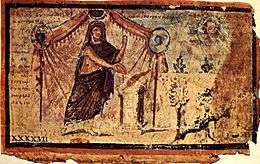Ambrosian Iliad
The Ambrosian Iliad or Ilias Picta (Milan, Biblioteca Ambrosiana, Cod. F. 205 Inf.) is a 5th-century illuminated manuscript on vellum of the Iliad of Homer. It is thought to have been produced in Constantinople during the late 5th or early 6th century AD, specifically between 493 and 508. This time frame was developed by Ranuccio Bandinelli and is based on the abundance of green in the pictures, which happened to be the color of the faction in power at the time.[1] It has since been reduced to a series of miniatures cut out of the manuscript. It is one of the oldest surviving illustrated manuscripts. In addition, it is the only surviving portion of an illustrated copy of Homer from antiquity and, along with the Vergilius Vaticanus and the Vergilius Romanus, one of only three illustrated manuscripts of classical literature to survive from antiquity.
| Wikimedia Commons has media related to Ambrosian Iliad. |
References
Further reading
- Guglielmo Cavallo: Osservazioni di un paleografo per la data e l'origine dell'Iliade Ambrosiana, in: Dialoghi di Archeologia 7, 1973, p. 70–85
- Weitzmann, Kurt, ed., Age of spirituality: late antique and early Christian art, third to seventh century, no. 193, 1979, Metropolitan Museum of Art, New York, ISBN 9780870991790; full text available online from The Metropolitan Museum of Art Libraries
